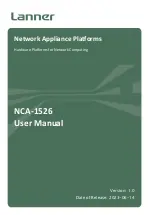
Motorola Netopia® Router Connection Profile Commands 3-15
cp
{
name
|
index
}
ppp authentication
{
send
|
receive
}
password
string
This command allows you to configure the send or receive PPP authentication password (or secret) associated
with the send or receive names.
cp
{
name
|
index
}
ppp usage
{
1
|
2
[
preemptible
] [
dynamic
] }
This command allows you to configure the characteristics of how the channels of the inter face are used. The
number indicates the maximum number of channels to use.
If you specify the keyword
preemptible
and more than one channel is being used for the connection, additional
calls (both data and voice, when applicable) may borrow a channel for their own use.
If you specify the keyword
dynamic
channels are added and removed from the connection based on bandwidth
usage. If traffic exceeds a cer tain threshold for a cer tain amount of time, and if there is a free channel
available, it will be used for the connection. Conversely, if more than one channel is being used by the
connection and traffic drops below a cer tain level for a cer tain amount of time, a channel will be dropped.
The keywords
dynamic
and
preemptible
may be specified only if the number of channels is 2.
Note:
With the current firmware, a dynamic 2B Channel profile will also be preemptible, regardless of whether
or not the
preemptible
keyword is specified.
Examples:
These examples illustrate all forms of the command that you are likely to use:
cp 1 ppp usage 1
cp 1 ppp usage 2
cp 1 ppp usage 2 preemptible
cp 1 ppp usage 2 dynamic
cp
{
name
|
index
}
frame-relay dlci auto-detect
{
yes
|
no
}
This command allows you to enable or disable the automatic detection of Frame Relay DLCIs when the profile is
used to establish a WAN connection.
cp
{
name
|
index
}
frame relay dlci multicast-number
{ 0 | 16 ... 991 }
This command allows you to specify the DLCI multicast number for the profile.
cp
{
name
|
index
}
telco direction
{
in
|
out
|
both
}
This command allows you to set whether this profile will be used to establish WAN connections (keyword
out
),
to establish inbound connections (keyword
in
), or to establish both (keyword
both
).
















































